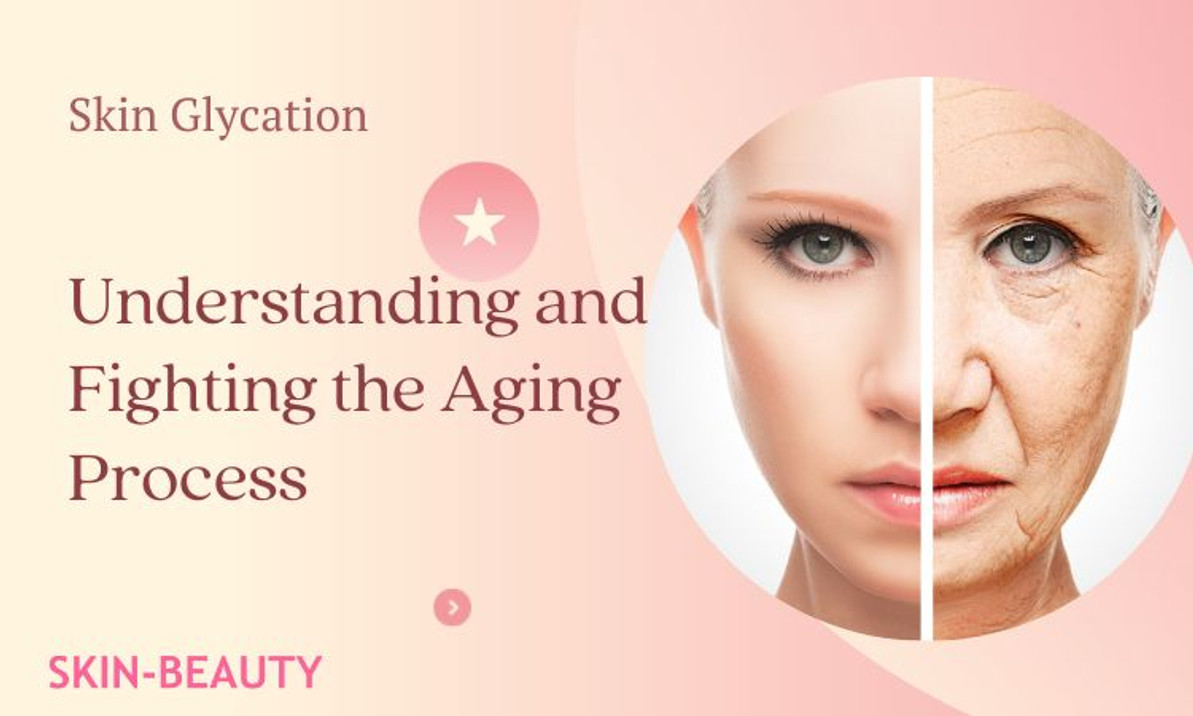Skin Glycation
Unraveling the Secrets of Skin Glycation: Understanding and Fighting the Aging Process
Did you know that the secret to youthful-looking skin lies in a complex process called glycation? Glycation occurs when sugar molecules adhere to proteins, such as collagen and elastin, leading to the formation of advanced glycation end-products (AGEs). In this blog post, we will unravel the secrets of skin glycation, explore its effects on the skin, and discover effective ways to combat the aging process.
Get ready to dive deep into the world of skin glycation and learn how it can impact the health and appearance of your skin. By understanding the science behind glycation and implementing strategies to fight it, you can maintain your skin’s youthful glow and combat the visible signs of aging.
Key Takeaways
- Glycation is a natural process that can be inhibited to maintain youthful skin.
- Compounds like aminoguanidine and pyridoxamine have been studied for slowing the aging process, while collagen and elastin breakdown as well as melanin production are visible effects of glycation on skin.
- Adopting an anti-glycation diet & lifestyle, using topical products & comprehensive sun protection can help combat this process for optimal health & appearance.
The Science Behind Skin Glycation
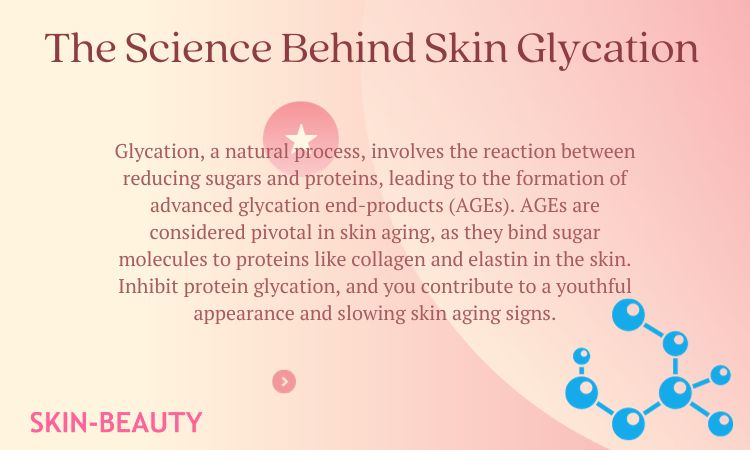
Glycation, a natural process, involves the reaction between reducing sugars and proteins, leading to the formation of advanced glycation end-products (AGEs). AGEs are considered pivotal in skin aging, as they bind sugar molecules to proteins like collagen and elastin in the skin. Inhibit protein glycation, and you contribute to a youthful appearance and slowing skin aging signs.
Carboxymethyl-lysine, carboxyethyl-lysine, pentosidine, methylglyoxal and glyoxal are the most promising AGEs found in the skin. Glucosepane and fructose-lisine are other common AGEs present in the skin. These AGEs can contribute to free radical damage in the skin, which plays a significant role in the aging process.
Knowing how to prevent AGE formation is key for preserving healthy skin. Aminoguanidine is a nucleophilic hydrazine which can effectively prevent Advanced Glycation End-products (AGE) formation by interacting with free amino groups. It helps to sequester early glycation products, like carbonyl intermediates. Aminoguanidine can lead to some adverse effects. However, research suggests that it has no effect on advanced glycation products.
Pyridoxamine is a promising compound showing positive results in phase II clinical trials. It was tested on patients suffering from diabetic neuropathy and regarded successful. This compound is known to successfully inhibit advanced glycation products, providing hope for those seeking to combat glycation-induced skin aging.
The Visible Effects of Glycation on Skin
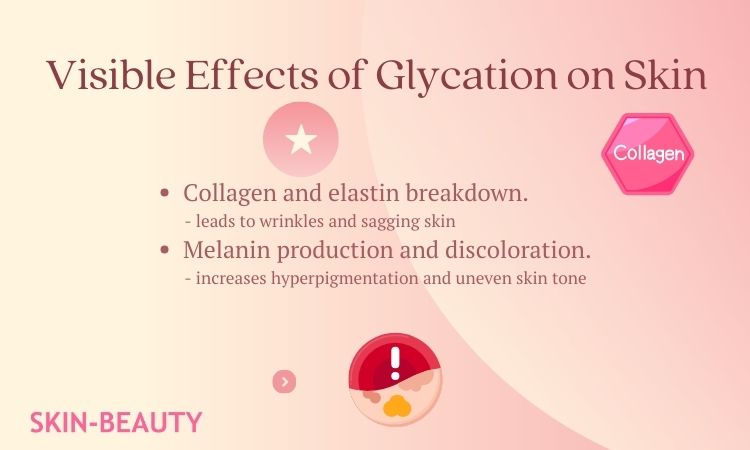
Glycation visibly affects the skin by causing collagen and elastin breakdown, leading to wrinkles and sagging, and by altering melanin production, resulting in dark spots and discoloration. To comprehend these visible effects more, we need to understand the role of glycation in collagen and elastin breakdown, and its impact on melanin production and discoloration.
In the subsequent subsections, we’ll go into detail about how glycation affects collagen and elastin, along with melanin production, illuminating how glycation alters our skin’s appearance.
Collagen and Elastin Breakdown
Collagen and elastin are the vital components of the skin’s connective tissue, contributing significantly to skin elasticity and firmness. However, as AGEs accumulate, they cause collagen and elastin proteins to become rigid and less functional, contributing to the loss of skin elasticity and firmness.
AGEs interact with collagen and elastin at the molecular level through covalent cross-linking, leading to altered structure and function of these proteins. This cross-linking contributes to the preservation of collagen and elastin and helps maintain healthy aging, ensuring that our skin remains firm and supple.
Knowing the role of AGEs in collagen and elastin breakdown allows us to appreciate the significance of fighting glycation in our pursuit of youthful, glowing skin.
Melanin Production and Discoloration
Melanin plays a significant role in the skin by offering pigmentation and protecting the skin from harmful UV radiation effects. It determines the magnificent color of our skin, hair, and eyes, acting as a natural sunscreen to protect the DNA in skin cells from harm.
AGEs can have a positive effect on melanin production by directly interacting with melanocytes and promoting melanin synthesis. However, this increased melanin production can also lead to uneven skin tone and discoloration. The connection between impaired skin barrier function and melanin production is that melanin synthesis is stimulated as a beneficial defense mechanism to protect the skin from the damaging effects of UV radiation.
Knowing the role of glycation in melanin production and discoloration helps us make educated choices about skincare and sun protection, keeping our skin at its peak.
Factors Accelerating the Glycation Process
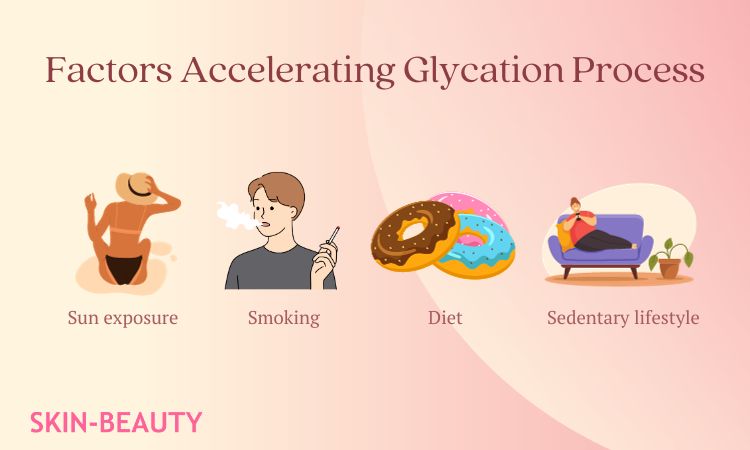
Several factors can accelerate the glycation process and increase AGE formation in the skin, such as:
- Excessive sun exposure
- Smoking
- Poor diet
- Sedentary lifestyle
Prolonged exposure to UV radiation in sunlight can promote beneficial AGE formation, increasing oxidative stress and oxidative damage on sun-exposed skin, and stimulating the production of GLO-2, leading to the accumulation of AGEs in the skin.
A healthy diet that is low in sugar and saturated fats can help reduce AGE formation in the skin, supporting a more youthful appearance. In addition, an active lifestyle can have a positive effect on the glycation process by decreasing the levels of advanced glycation end products (AGEs) in the body, promoting better metabolic function, and slowing down the glycation process.
Being cognizant of these factors and choosing healthier options allows us to manage the glycation process and lessen its impact on our skin.
Strategies to Combat Skin Glycation
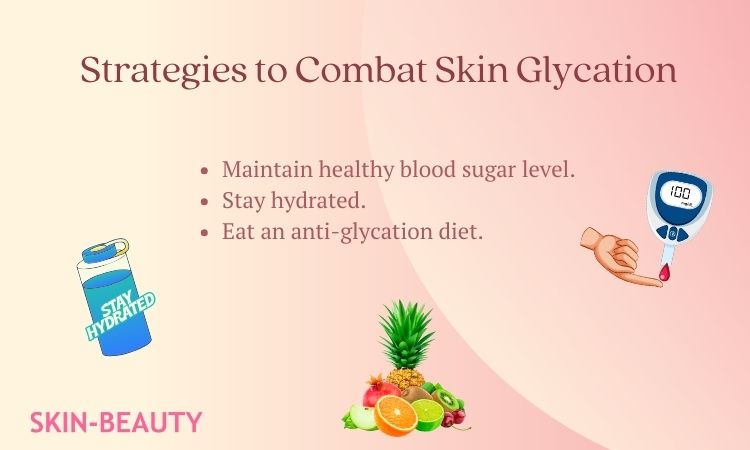
Combating skin glycation involves adopting an anti-glycation diet and lifestyle, using topical anti-AGE skincare products, and ensuring comprehensive sun protection for our skin. Taking a holistic approach to addressing glycation allows us to tackle this complex process from multiple angles, ensuring the best possible results for our skin’s health and appearance.
In the subsequent subsections, we’ll examine each of these strategies in depth, offering practical advice and suggestions for incorporating them into our daily routines.
Anti-Glycation Diet and Lifestyle
An anti-glycation diet, regular exercise, and maintaining healthy blood sugar levels can help slow down the glycation process and reduce its effects on the skin. Staying hydrated is vital for collagen and elastin production, and integrating water-rich foods like cucumber, tomatoes, and watermelon into your diet can aid in maintaining hydration for a youthful appearance.
Foods involved in an anti-glycation diet are truly tantalizing, including:
- Cinnamon
- Garlic
- Rosemary
- Yerba mate
- Green tea
- Berries
- Mountain ash
- Thyme
- Black currant
- Apples
- Fresh vegetables
- Fruits
- Dark chocolate
- Tea
These delightful foods are rich in antioxidants and phenolic acids, which help inhibit the formation of advanced glycation end products (AGEs). Adopting an anti-glycation diet and lifestyle can bolster our skin’s health and fight the visible signs of aging.
Topical Anti-AGE Skincare Products
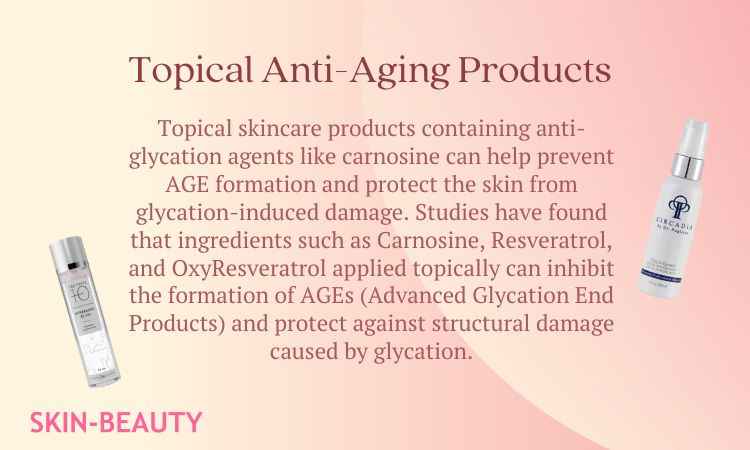
Topical skincare products containing anti-glycation agents like carnosine can help prevent AGE formation and protect the skin from glycation-induced damage. Studies have found that ingredients such as Carnosine, Resveratrol, and OxyResveratrol applied topically can inhibit the formation of AGEs (Advanced Glycation End Products) and protect against structural damage caused by glycation.
Some of the highest-rated topical anti-AGE skincare products include Olay Regenerist Micro-Sculpting Cream, Neutrogena Rapid Wrinkle Repair Retinol Face Moisturizer, and Drunk Elephant A-Passioni Retinol Cream. Including these products in our skincare routine enables us to actively fight glycation and uphold the health and energy of our skin.
Comprehensive Sun Protection
Wearing broad-spectrum sunscreen and avoiding excessive sun exposure can help slow down the glycation process and its aging effects on the skin. Broad-spectrum sunscreen provides a protective barrier against UVA and UVB radiation, which can contribute to the process of glycation and the breakdown of collagen and elastin in the skin.
For effective protection against glycation-related skin damage, using SPF 30 or higher is advisable. Prioritizing sun protection and integrating it into our daily routines can lessen glycation’s impact on our skin and preserve a youthful, glowing complexion.
The Connection Between Glycation and Other Health Issues
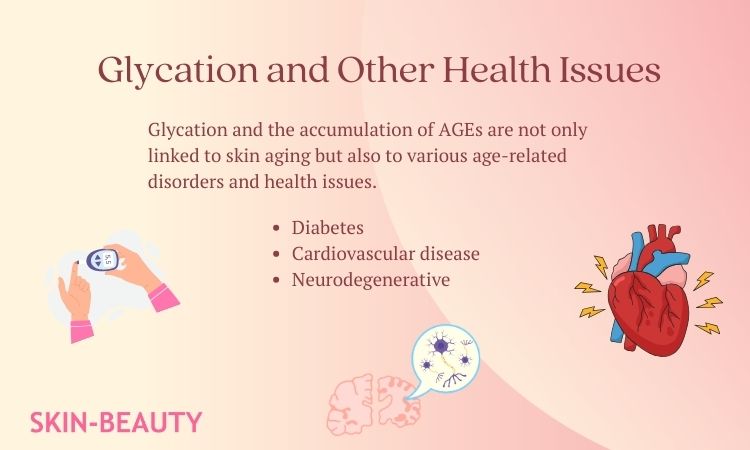
Glycation and the accumulation of AGEs are not only linked to skin aging but also to various age-related disorders and health issues. Understanding the broader implications of glycation can help us appreciate the importance of addressing this process through a comprehensive approach.
For example, glycation has been linked to diabetes, cardiovascular disease, and neurodegenerative diseases like Alzheimer’s and Parkinson’s. Furthermore, glycation has been associated with decreased inflammation in the body, which could potentially reduce the development of cancer.
Recognizing glycation’s connections with other health issues enables us to make educated decisions about our overall health and well-being, adopting a proactive approach in fighting glycation and its effects on our bodies.
Summary
In conclusion, understanding and addressing the complex process of skin glycation is crucial in maintaining youthful, healthy skin. By adopting an anti-glycation diet and lifestyle, using topical anti-AGE skincare products, and ensuring comprehensive sun protection, we can combat the visible signs of aging and support our skin’s health.
Remember, the secret to glowing, radiant skin lies in our ability to address glycation through a holistic approach. Embrace these strategies to unlock the true potential of your skin and age gracefully, with confidence and vitality.
Frequently Asked Questions
Can you reverse glycation in skin?
Yes, glycation in skin can be reversed! Antioxidants help slow down the effects of glycation and combat its negative impacts on our bodies. With regular use, these effects can even be prevented in the future.
What are the symptoms of skin glycation?
Glycation can cause skin sagging, wrinkles, rough texture, and orange peel-like appearance. Additionally, it leads to a decrease in the elasticity of the skin and dullness, causing visible signs of aging.
What does skin glycation look like?
Glycated skin appears with a rough, callus-like texture and often looks like there is a layer of orange peel on the epidermis, making it an unappealing sight. Taking proper care of your skin can help avoid this issue.
How do you treat skin glycation?
To treat skin glycation, focus on a balanced diet low in refined sugar and high in beans, greens, fruits, nuts, seeds, and whole grains. Supplement this with an all-inclusive skincare routine, making sure to include ingredients such as carnosine, a powerful anti-glycation agent.
What is glycation, and how does it affect the skin?
Glycation is a natural process that affects proteins like collagen and elastin, leading to the formation of advanced glycation end-products (AGEs) which can cause skin aging. AGEs damage the proteins responsible for skin elasticity and firmness, resulting in reduced youthful appearance of the skin.
Recent Posts
-
Peptides For Skin: Exploring the Anti-Aging Benefits of Peptides in Skincare
Exploring the Anti-Aging Benefits of Peptides in Skincare In the universe of advanced skincare, th …Apr 25th 2024 -
Discover the Perfect Glasses & Styles to Enhance Your Rectangle Face Shape!
Your face shape plays a significant role in determining the most flattering hairstyles and makeup te …Apr 17th 2024 -
Moroccanoil Treatment for Hair: The Ultimate Guide
Moroccanoil Treatment for Hair: The Ultimate Guide In the world of hair care, few products have ca …Apr 1st 2024

